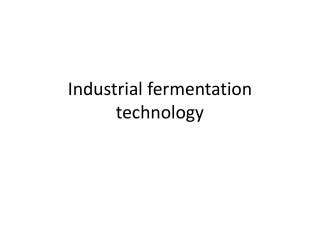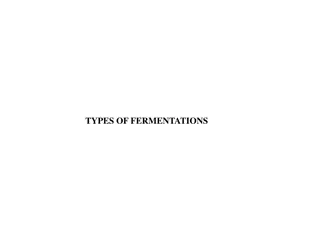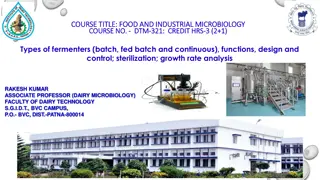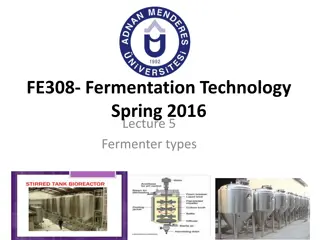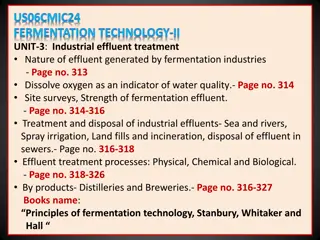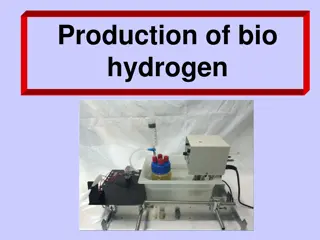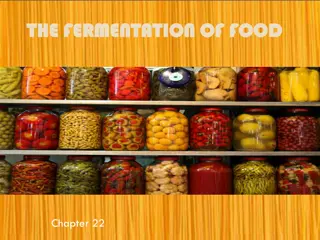
The Types of Fermentation Process
Learn about the different types of fermentation - Lactic Acid, Alcohol, Acetic Acid, and Ethanol fermentation. Discover how organisms convert starch or sugar to alcohol or acids, releasing energy anaerobically. Explore the advantages and applications of fermentation in various industries.
Download Presentation

Please find below an Image/Link to download the presentation.
The content on the website is provided AS IS for your information and personal use only. It may not be sold, licensed, or shared on other websites without obtaining consent from the author. If you encounter any issues during the download, it is possible that the publisher has removed the file from their server.
You are allowed to download the files provided on this website for personal or commercial use, subject to the condition that they are used lawfully. All files are the property of their respective owners.
The content on the website is provided AS IS for your information and personal use only. It may not be sold, licensed, or shared on other websites without obtaining consent from the author.
E N D
Presentation Transcript
StudyMafia.Org Types of Fermentation Submitted To: Submitted By: Studymafia.org Studymafia.org
Table Contents Definition Introduction Types of Fermentation Advantages of Fermentation Conclusion 2
Definition Fermentation is an enzyme catalysed, metabolic process whereby organisms convert starch or sugar to alcohol or an acid anaerobically releasing energy. The science of fermentation is called zymology . 3
Introduction Fermentation is an anaerobic biochemical process. In fermentation, the first process is the same as cellular respiration, which is the formation of pyruvic acid by glycolysis where net 2 ATP molecules are synthesised. In the next step, pyruvate is reduced to lactic acid, ethanol or other products. Here NAD+ is formed which is re-utilized back in the glycolysis process. 4
Types of Fermentation Lactic Acid Fermentation Lactic acid is formed from pyruvate produced in glycolysis. NAD+ is generated from NADH. Enzyme lactate dehydrogenase catalyses this reaction. Lactobacillus bacteria prepare curd from milk via this type of fermentation. During intense exercise when oxygen supply is inadequate, muscles derive energy by producing lactic acid, which gets accumulated in the cells causing fatigue. 6
Types of Fermentation Alcohol Fermentation This is used in the industrial production of wine, beer, biofuel, etc. The end product is alcohol and CO2. Pyruvic acid breaks down into acetaldehyde and CO2 is released. In the next step, ethanol is formed from acetaldehyde. NAD+ is also formed from NADH, utilized in glycolysis. Yeast and some bacteria carry out this type of fermentation. 7
Types of Fermentation Acetic acid Fermentation Vinegar is produced by this process. This is a two- step process. The first step is the formation of ethyl alcohol from sugar anaerobically using yeast. In the second step, ethyl alcohol is further oxidized to form acetic acid using acetobacter bacteria. Microbial oxidation of alcohol to acid is an aerobic process. 8
Types of Fermentation Ethanol Fermentation In ethanol fermentation, the pyruvate produced through glycolysis is converted to ethanol and carbon dioxide in two steps. First, the pyruvate releases carbon dioxide to form a two-carbon compound called acetaldehyde. Next, acetaldehyde is reduced by NADH to ethanol, thereby regenerating the NAD+ for use in glycolysis. 9
Types of Fermentation Butyric acid Fermentation This type of fermentation is characteristic of obligate anaerobic bacteria of genus clostridium. This occurs in retting of jute fibre, rancid butter, tobacco processing and tanning of leather. Butyric acid is produced in the human colon as a product of dietary fibre fermentation. It is an important source of energy for colorectal epithelium.
Advantages of Fermentation Using suitable microorganisms and specified conditions different kinds of fermentation products are formed namely:- Wine Beer Biofuels Yoghurt Pickles Bread Sour foods containing lactic acid 11
Advantages of Fermentation Fermentation can make food nutritious, digestible and flavoured. There are many benefits of consuming fermented food. It improves digestion and helps to maintain intestinal bacteria It has an anti-cancer effect. Improves immune system Reduces lactose intolerance 12
Conclusion Fermentation is a metabolic process that produces chemical changes in organic substrates through the action of enzymes. In biochemistry, it is narrowly defined as the extraction of energy from carbohydrates in the absence of oxygen. 14
References Google.com Wikipedia.org Studymafia.org Slidespanda.com
Thanks To StudyMafia.org


